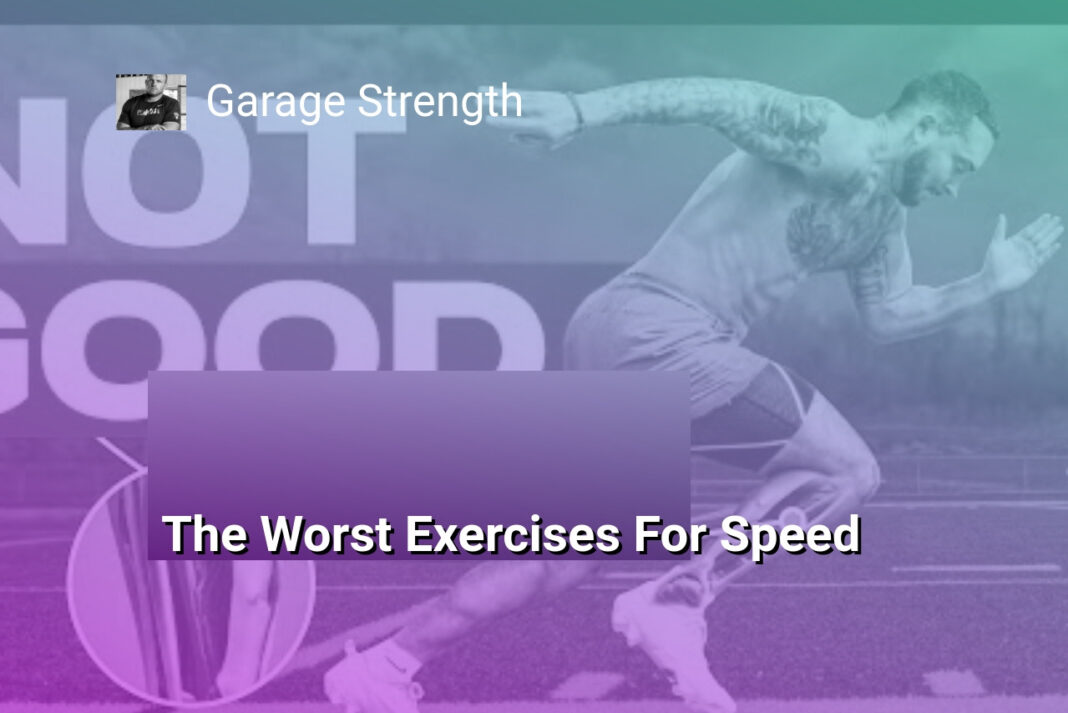The Bottom Line:
- As an Olympic strength coach, I’ve helped athletes and coaches develop comprehensive programs to improve speed, acceleration, change of direction, and top speed performance.
- I believe that while bodybuilding training can have a positive impact on sports performance, especially for novice or beginner athletes, certain exercises like the leg press, bench press, and deadlift may not be the best choices for improving speed.
- Instead, I recommend focusing on exercises that develop explosive power and force production, such as power snatches, power cleans, and snatch pulls, as these movements are commonly used by the world’s fastest athletes.
- Additionally, I caution against certain running exercises, as they can lead to poor ankle stiffness and reduce the athlete’s ability to generate the high ground reaction forces necessary for top-end speed.
- Overall, my approach emphasizes the importance of selecting exercises and training methods that are specifically tailored to the demands of speed and power-based sports, rather than relying solely on traditional bodybuilding or general strength training techniques.
The Downside of the Leg Press for Speed
Potential Drawbacks of the Leg Press for Speed Development
While the leg press can be an effective exercise for targeting the quadriceps and building muscular strength, it may not be the optimal choice for athletes focused on improving speed and acceleration. One of the primary concerns with the leg press is the limited range of motion and the fixed movement pattern, which can differ significantly from the dynamic, multi-joint movements involved in sprinting.
Lack of Functional Movement Patterns
During the leg press, the athlete’s body is in a fixed position, with the hips and knees primarily responsible for the movement. This contrasts with the more complex, multi-joint actions required for sprinting, which involve the coordination of the hips, knees, and ankles. The limited range of motion and isolated nature of the leg press may not adequately prepare the athlete for the dynamic, explosive movements needed for effective acceleration and top-end speed.
Potential for Muscle Imbalances
Another potential drawback of the leg press is the risk of developing muscle imbalances. By primarily targeting the quadriceps, the leg press can lead to an overemphasis on this muscle group, potentially creating an imbalance with the hamstrings and other posterior chain muscles. This imbalance can negatively impact the athlete’s movement patterns and increase the risk of injury, especially during high-speed running.
To address these concerns, coaches and athletes may consider incorporating more functional, multi-joint exercises that better mimic the movement patterns and muscle activation required for sprinting. This could include exercises such as Olympic lifts, plyometric drills, and sprinting-specific strength training. By focusing on developing well-rounded, explosive power and maintaining muscular balance, athletes can better prepare their bodies for the demands of high-speed running and improve their overall speed and performance.
Bench Press Limitations and Better Alternatives
Optimizing Strength Training for Speed: Avoiding the Bench Press Trap
The bench press, while a staple in many strength training programs, may not be the most effective exercise for improving speed and acceleration. While it can be used to increase global recruitment and muscle activation in the preparation phase, as an athlete gets closer to their peak performance, the bench press may become counterproductive.
The primary reason is that the bench press can lead to excessive hypertrophy in the upper body, particularly the pecs, shoulders, and triceps. This increased muscle mass, while beneficial for overall strength, may not translate directly to improved speed and acceleration. In fact, the additional weight could potentially have a negative impact on the athlete’s relative strength, which is a key factor in speed development.
Alternatives to the Bench Press for Speed Development
Instead of the traditional bench press, coaches and athletes should consider incorporating exercises that focus on explosive power and trunk stability. One such alternative is the dumbbell alternating press, which challenges the athlete to maintain core stability while performing a pressing movement. As the athlete gets closer to their peak, they can transition to plyometric exercises like clap push-ups, which can better stimulate the nervous system and improve the rate of force production.
Embracing the Power of Olympic Lifts
Another key consideration for speed development is the importance of hip and ankle mobility. Traditional exercises like the deadlift, while valuable for overall strength, can sometimes lead to tightness in the hip flexors, which can negatively impact running mechanics. Instead, coaches should look to incorporate Olympic lifting variations, such as the power snatch, power clean, and their derivatives.
These explosive movements not only develop power and force production but also help athletes learn to apply force rapidly into the ground, a critical component of speed and acceleration. By observing the training habits of the world’s elite sprinters, coaches can gain valuable insights and incorporate these powerful exercises into their athletes’ programs.
Rethinking the Deadlift for Speed Development
Enhancing Hip Mobility and Explosive Power
The deadlift, a staple exercise in many strength training programs, may not be the optimal choice for developing speed and acceleration. While the deadlift can build overall strength, it may not directly translate to the specific demands of sprinting. One of the primary concerns with the deadlift is its potential impact on hip mobility and the risk of tightening the hip flexors.
Prioritizing Explosive Movements
Instead of the traditional deadlift, the article suggests focusing on explosive, power-based exercises that better mimic the mechanics of sprinting. Exercises like the power snatch, power clean, and their variations are recommended as they require the athlete to generate and transfer force rapidly through the kinetic chain. These movements not only develop explosive power but also help the athlete learn to apply force effectively into the ground, a crucial aspect of speed development.
Incorporating Plyometric Exercises
In addition to the Olympic-style lifts, the article also highlights the importance of incorporating plyometric exercises, such as clap push-ups, to enhance the nervous system’s ability to fire quickly. These exercises challenge the athlete to produce force rapidly, which can translate directly to improvements in acceleration and top-end speed.
By shifting the focus away from the traditional deadlift and towards more explosive, power-based movements and plyometrics, the article suggests that athletes can better optimize their training for speed development. This approach aligns with the insights from elite sprinters, who prioritize these types of exercises in their training regimens.
The Power of Weightlifting Variations
Mastering Weightlifting Variations for Speed
The key to developing explosive speed lies in the strategic incorporation of weightlifting variations into your training regimen. These dynamic movements not only build raw power but also enhance the body’s ability to generate and transfer force efficiently.
Unlocking the Potential of Power Cleans and Snatches
As evidenced by the world’s fastest athletes, weightlifting exercises like the power clean and power snatch are invaluable for developing speed and acceleration. These movements challenge the body to rapidly generate force, recruit a high percentage of muscle fibers, and improve the nervous system’s ability to fire quickly. By mastering the technical execution of these lifts, athletes can develop the explosive strength and power necessary to excel in high-speed activities.
Leveraging Accessory Lifts for Targeted Development
Complementing the power cleans and snatches, exercises such as the snatch pull and clean pull can help establish a rhythmic pattern and enhance the body’s ability to handle high ground reaction forces. These accessory lifts allow athletes to focus on the rapid application of force, building the neuromuscular foundations required for top-end speed. Additionally, incorporating pause variations and plyometric elements can further refine the athlete’s ability to produce and transfer power efficiently.
By integrating a comprehensive program of weightlifting variations, athletes can unlock their true potential for speed and explosiveness. This holistic approach, drawing from the training methods of the world’s elite sprinters, provides a powerful blueprint for enhancing athletic performance and achieving new levels of success.
Avoiding Running Exercises That Hinder Speed
Avoiding Excessive Endurance Running for Speed
While running is an essential component of speed development, certain types of running exercises can actually hinder speed performance. One such exercise to avoid is excessive endurance running. Long-distance running, such as prolonged jogging or distance training, can lead to adaptations that are counterproductive to developing pure speed and explosiveness.
The Importance of Specificity in Speed Training
When training for speed, it’s crucial to maintain a high level of specificity in the exercises and movements performed. Endurance running, while beneficial for overall fitness, does not directly translate to improvements in acceleration, top-end speed, and change of direction. In fact, the adaptations from endurance running, such as increased muscle endurance and a shift towards slower-twitch muscle fibers, can actually impede the development of the power and explosiveness required for elite-level speed.
Incorporating Targeted Speed Work
Instead of relying heavily on endurance running, the focus should be on incorporating targeted speed-specific exercises and training methods. This includes sprinting drills, plyometrics, resisted sprint training, and Olympic-style weightlifting movements. These exercises directly target the neuromuscular and biomechanical qualities necessary for optimal speed development, allowing athletes to maximize their potential for acceleration, top-end speed, and agility.
By avoiding excessive endurance running and instead prioritizing speed-specific training, athletes can optimize their physical capabilities and unlock their true potential for faster performance. The key is to maintain a balanced approach, incorporating both speed-focused exercises and general conditioning to create a well-rounded training program.





